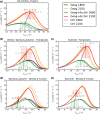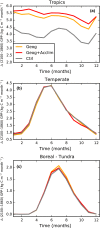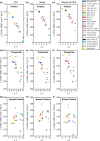Large sensitivity in land carbon storage due to geographical and temporal variation in the thermal response of photosynthetic capacity
- PMID: 29635689
- PMCID: PMC5969232
- DOI: 10.1111/nph.15100
Large sensitivity in land carbon storage due to geographical and temporal variation in the thermal response of photosynthetic capacity
Abstract
Plant temperature responses vary geographically, reflecting thermally contrasting habitats and long-term species adaptations to their climate of origin. Plants also can acclimate to fast temporal changes in temperature regime to mitigate stress. Although plant photosynthetic responses are known to acclimate to temperature, many global models used to predict future vegetation and climate-carbon interactions do not include this process. We quantify the global and regional impacts of biogeographical variability and thermal acclimation of temperature response of photosynthetic capacity on the terrestrial carbon (C) cycle between 1860 and 2100 within a coupled climate-carbon cycle model, that emulates 22 global climate models. Results indicate that inclusion of biogeographical variation in photosynthetic temperature response is most important for present-day and future C uptake, with increasing importance of thermal acclimation under future warming. Accounting for both effects narrows the range of predictions of the simulated global land C storage in 2100 across climate projections (29% and 43% globally and in the tropics, respectively). Contrary to earlier studies, our results suggest that thermal acclimation of photosynthetic capacity makes tropical and temperate C less vulnerable to warming, but reduces the warming-induced C uptake in the boreal region under elevated CO2 .
Keywords: V cmax; geographical variation of the temperature response of Vcmax and Jmax; modelling photosynthesis; temperature response of photosynthetic capacity; thermal acclimation; tropics.
© 2018 The Authors. New Phytologist © 2018 New Phytologist Trust.
Figures







References
-
- Arneth A, Mercado L, Kattge J, Booth BBB. 2012. Future challenges of representing land‐processes in studies on land‐atmosphere interactions. Biogeosciences 9: 3587–3599.
-
- Arora VK. 2003. Simulating energy and carbon fluxes over winter wheat using coupled land surface and terrestrial ecosystem models. Agriculture and Forest Meteorology 118: 21–47.
-
- Berry J, Bjorkman O. 1980. Photosynthetic response and adaptation to temperature in higher plants. Annual Review of Plant Physiology 31: 491–543.
-
- Booth BBB, Jones CD, Collins M, Totterdell IJ, Cox PM, Sitch S, Huntingford C, Betts RA, Harris GR, Lloyd J. 2012. High sensitivity of future global warming to land carbon cycle processes. Environmental Research Letters 7: 024002.
-
- Cavaleri MA, Reed SC, Smith WK, Wood TE. 2015. Urgent need for warming experiments in tropical forests. Global Change Biology 21: 2111–2121. - PubMed
Publication types
MeSH terms
Substances
LinkOut - more resources
Full Text Sources
Other Literature Sources

